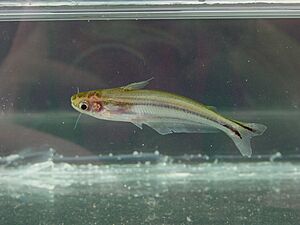Pareutropius debauwi facts for kids
Quick facts for kids Pareutropius debauwi |
|
|---|---|
 |
|
| Conservation status | |
| Scientific classification |
The Pareutropius debauwi, also known as the African glass catfish, is a cool fish that belongs to a group called Actinopterygii, which are ray-finned fishes. It's part of the Schilbeidae family, known as Schilbid catfishes. This family has 9 different groups (genera) and 46 types of fish (species).
Contents
What's in a Name?
The name of this fish's group, Pareutropius, comes from ancient Greek words. Par means "beside or near," eu means "well," and tropis means "keel." This describes how the fish's body is a bit flattened on the sides. The second part of its name, debauwi, is named after a person, but the original text had a typo and mentioned vittatus which means "covered with stripes." This part of the name refers to the cool stripe patterns you can see on this fish.
What Does It Look Like?
The African glass catfish is a shiny silver color. It has one main fin on its back with a single strong spine and up to six soft rays. On each side of its head, it has seven or eight small bones called branchiostegal rays. It also has one pair of barbels (like whiskers) near its mouth, which it uses to feel around. A dark stripe runs along the middle of its body. This stripe continues onto its tail fin, which doesn't have any dark spots. You might also notice a small, dark line at the base of its anal fin (the fin on its underside near the tail).
Where Does It Live?
This fish comes from Africa. You can find it in countries like Angola, the Republic of the Congo, the Democratic Republic of the Congo, and Gabon. It likes to live in shallow parts of water systems. The African glass catfish is a freshwater species, meaning it lives in rivers and lakes, not the ocean. It prefers warm, tropical waters. You can find these fish in both large and small rivers where the water flows at a moderate speed.
Biology and Reproduction
Pareutropius debauwi are omnivores, which means they eat both plants and animals. Some of them are even carnivorous and enjoy eating insects. When it's time to have babies, a male and female fish will pair up. They usually reproduce when rivers flood. Female fish are often bigger than males and have a rounder, shorter part where they release eggs. These fish are oviparous, meaning they lay eggs. The parents don't guard the eggs or take care of their young. These fish are very active during the day (they are diurnal) and love to swim together in big groups (they are a schooling species). They can grow up to 15 centimeters long and usually live for about eight years.
Life in an Aquarium
If you want to keep African glass catfish as pets, it's best to have them in a large group, with at least ten or more fish. They are very active, so they need a lot of space to swim around. They also prefer dim lighting. The water in their tank should have a moderate current, like a gentle river. The temperature should be between 23°C to 26°C (about 73°F to 79°F). They are most comfortable in water that is fairly neutral, with a pH level around 6.5 to 7.5. For food, they like a mix of flakes, small pellets, and frozen foods. Foods like Daphnia (tiny crustaceans), mosquito larvae, or brine shrimp are perfect for them. Breeding Pareutropius debauwi in a home aquarium is tricky and not usually suggested, but it can be done if you have very specific conditions.
Conservation Status
The African glass catfish is found in many places and is not currently facing any serious threats.



